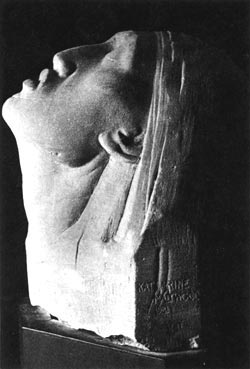John & Katharine Maltwood Collection
| View the Collection |
History of the Collection |
John & Katharine Maltwood |
Information Resources |
The Maltwoods Introduction
Katharine Maltwood Biography
Early Sculpture
- Education - Magna Mater - London Salon (1912) - Primeval Canada - A Vision - Contemporary Style - Eric Gill Post-War Works Glastonbury Zodiac Life in Victoria, B.C. Monograph (pdf 1.14 MB)
About Us Contact Us Visit Us Site Map

Early Sculpture - Part 4: Primeval Canada | |||||
A work which attracted considerable attention was Katharine Maltwood's maquette for a monument, Primeval Canada Awakening to Her Destiny, the head of which was carved from Portland stone. The head alone survives and was first exhibited at the Arts and Crafts Society in the Grosvenor Gallery in 1912 and again at the London Salon in 1913. The following year the front portion with a photograph of the whole appeared at the London Salon at Holland Park Hall. The work represents the first indication of an interest in Canada and according to the Lady's Pictorial of July 11, 1914 the monument was intended for erection in Canada. A report in the Standard newspaper of June 12, 1914, described it in the following way: The conception is that of a colossal woman, clothed in pine forests, with her head upturned to the skies and her hands ather sides protecting symbolic figures of moose and buffalo which rest upon the rectangular blocks forming the base of the monument. Between the feet of the woman stands a bearded figure, small in proportion, of a pioneer backwoodsman with an axe, his arm being outstretched as if in worship of Canada rising before and above him ... the suggestion might be that of a mountain coming to life before the impassioned gaze of the pioneer. The upturned face displays broad simplified features, Indian and archaic in style, and was much admired. For instance The Observer art critic wrote: "The striving after the broad simplicifacation of Egyptian or Assyrian archaic art must be welcomed". A similar approach can be seen in the work of Katharine Maltwood's contemporaries such as Eric Gill. As a contrast to the immobility of the upper group the reliefs on the base represent figures in movement, track laying and erecting telephone wires. In style they are reminiscent of the sculpture of Constantin Meunier who was noted for his images of labour and the working man. As a whole the monument met with great praise at the time and The Observer critic of 1914 went so far as to say it "promises to be one of the most remarkable works produced by an English sculptor."
All content on this page is copyright © 30 January, 2006 |
|||||

